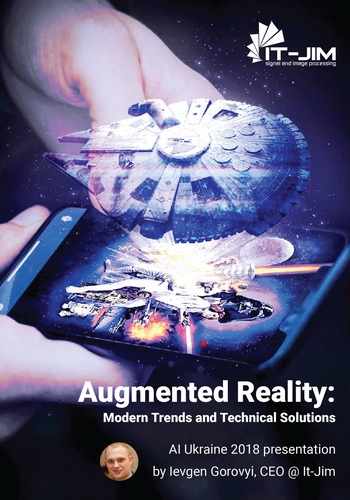Write a Review
Verified Profile
It-Jim is a leading AI company primarily focusing on computer vision and natural language processing (NLP) development and AI-powered mobile applications.
We are experts in
- Custom computer vision development: image segmentation, pattern recognition, object detection and tracking, face detection and recognition, OCR& text analysis
- 3D computer vision solutions: 3D reconstruction, SfM/SLAM, visual localization, 3D object detection and tracking, 3D meshing, etc.
- NLP development: text classification and summarization; sentiment analysis; NER; information extraction; chatbots; OpenAI's API; GPT-3, BERT, T5 and other LLMs, etc.
- Audio processing: text-to-speech and speech-to-text solutions, voice cloning, emotion recognition, speech recognition and noise suppression;
- AI-powered mobile applications: deployment of DL models on edge, custom C++ code optimization for mobile devices; MLKit, CoreML, ARKit, RoomPlanAPI, SceneKit; iPhone sensors fusion (camera, LiDAR, TrueDepth, IMU, mic)
- Deep learning solutions
- Extended reality (XR)
- Embedded & Robotics solutions
- Signal processing
At our company, we offer full-scale development services, including technical consulting and project management, and support our clients throughout the entire product lifecycle. Whether you need a one-time project or ongoing technical support, we are committed to delivering high-quality solutions that meet your needs and exceed your expectations.
Locations
Ukraine
17 Alchevskykh Str.,
Kharkiv,
Kharkiv
61002
+380668205318
United States
30 N Gould St Ste R,
Sheridan,
Wyoming
82801
+13025661501
Focus Areas
Service Focus
- Artificial Intelligence
- Software Development
- AR & VR Development
Client Focus
- Medium Business
- Small Business
Industry Focus
- Automotive
- Art, Entertainment & Music
- Healthcare & Medical
It-Jim Executive Interview

Ievgen Gorovyi
CEO
Kindly share your feedback on how GoodFirms has been doing so far in increasing your visibility among potential clients.
We constantly receive traffic from GoodFirms to our website and use this platform to showcase our expertise, portfolio, and most importantly, feedback from our previous and current clients. What's it like to work with It-Jim? What to expect in terms of delivery, service, and dedication? No one can provide this information better than the clients you've been working with for a long time.
Please introduce your company and give a brief about your role within the organization.
It-Jim is a Ukraine-based company specializing in artificial intelligence solutions. Or major expertise lies in visual intelligence and signal processing. As a team of experts with Ph.D. degrees in various mathematical disciplines, we provide technical consulting, R&D services, and custom software development for any image and video analysis problems. Computer vision, machine, and deep learning, extended reality, signal and image processing, NLP, and audio processing – we have completed dozens of projects in each of these categories.
I founded the company in 2015 and have served as a CEO ever since. My role is mainly strategic – business development, anticipating the company's growth path, analyzing trends and technologies so that our expertise expands accordingly, and working with customers and leads. I’m also actively involved in technical leadership and management of multiple R&D and software engineering groups. Most of the core team has grown under my direct supervision at It-Jim.
I founded the company in 2015 and have served as a CEO ever since. My role is mainly strategic – business development, anticipating the company's growth path, analyzing trends and technologies so that our expertise expands accordingly, and working with customers and leads. I’m also actively involved in technical leadership and management of multiple R&D and software engineering groups. Most of the core team has grown under my direct supervision at It-Jim.
What is the story behind starting this company?
After finishing my Ph.D. in image and signal processing I was really looking for new horizons and climbing new heights. I successfully tried my hand at freelancing and after a short while realized that I felt ambitious to work not only on my own but to build up a team of really smart and talented people – the kind of people with whom I communicated during my graduate studies. One day I came across the field of computer vision - it was around the time AlexNet had appeared and there was a buzz around deep learning - and I knew straight away that this was an area I wanted to dive into. I put together a team of scientists and developers and took the best of two worlds. On the one hand, we had scientific experience, the ability to analyze and conduct research, and openness to complex problems with no straightforward solutions. On the other hand, our team was skilled to integrate high-quality solutions across multiple platforms and hardware, from a mobile device, an embedded board, and a web browser up to a distributed system in the cloud. This combination has proven to work extremely well.
What are your company’s business model–in house team or third party vendors/ outsourcing?
For the development of algorithms and the research part of the projects we always employ the in-house core team of computer vision and deep learning engineers. In this way, we guarantee the quality of solutions that are well-balanced in terms of accuracy, performance, and computation resources and that they are delivered with clear communication and respect for deadlines.
We also have mobile and web developers as well as business analysts, project managers, and QA engineers on board. For development in other areas, for example, in back-end or UI/UX design, we have partners with whom we have been cooperating for a long time.
We also have mobile and web developers as well as business analysts, project managers, and QA engineers on board. For development in other areas, for example, in back-end or UI/UX design, we have partners with whom we have been cooperating for a long time.
How does your company differentiate itself from the competition?
I believe that the combination of academic excellence with solid commercial development experience in such a complex field as artificial intelligence makes our company unique. And, of course, the team. That's what I'm most proud of. We choose our people very carefully and do everything we can to foster the development of all newcomers. Most junior developers come to the company after completing a trainee program, which involves a 2-month mentoring by our leading professionals and working on real projects. We have also developed a custom computer vision course that most of them take at the beginning of their career.
But it is not only for internal use that we develop educational programs. We pay great attention to the growth and development of the Ukrainian CV community, regularly holding internships and winter schools, giving lectures for university students or lecturers of IT specialties to improve their skills, and giving tutorials at scientific conferences.
But it is not only for internal use that we develop educational programs. We pay great attention to the growth and development of the Ukrainian CV community, regularly holding internships and winter schools, giving lectures for university students or lecturers of IT specialties to improve their skills, and giving tutorials at scientific conferences.
What industries do you generally cater to? Are your customers repetitive? If yes, what ratio of clients has been repetitive to you?
Most of our customers fall into one of the following categories: healthcare, automotive, entertainment, sports analytics, surveillance, or retail.
Working with current customers is a key factor for business growth, and we do our best to find those clients with whom we believe and with whom we want to grow side-by-side for many years. A return rate of over 50% indicates that we are quite successful in these endeavors.
Working with current customers is a key factor for business growth, and we do our best to find those clients with whom we believe and with whom we want to grow side-by-side for many years. A return rate of over 50% indicates that we are quite successful in these endeavors.
Please share some of the services that you offer for which clients approach you the most for?
Our non-exhaustive list of the services we are most often contacted for includes custom computer vision software development, especially for iOS and web, deep learning solutions and their deployment on edge devices, extended reality (XR) development, digital signal processing research, and technical consulting.
What is your customer satisfaction rate according to you? What steps do you take to cater to your customer’s needs and requirements?
Let the reviews and ratings here on GoodFirms do the talking instead of us. Our track record says that at least 9 times out of 10 our customers are satisfied with what we have delivered.
Our steps to make our clients happy include regular and clear communication, providing them with R&D reports describing all phases of algorithm development, business analysis and participation in the product development process, post-project support, etc.
Our steps to make our clients happy include regular and clear communication, providing them with R&D reports describing all phases of algorithm development, business analysis and participation in the product development process, post-project support, etc.
What kind of support system do you offer to your clients for catering to their queries and issues?
Most questions and problems are easily resolved or even never arise thanks to regular communication. Our customers often participate in Slack channels and can get a first-hand response from a technical leader, project manager, or engineer if needed. Should the issue appear after the project completion, we are still there to help the client out.
What kind of payment structure do you follow to bill your clients? Is it Pay per Feature, Fixed Cost, Pay per Milestone (could be in phases, months, versions etc.)
The most common scheme involves two stages. First, we start with a POC with a fixed budget. In most cases this is a win-win deal - both the client and we get to know each other better, we demonstrate our competence by providing a working prototype, and the client shows himself as a reliable partner. Then we move on to time and material payments paid on a 2-week sprint basis.
Do you take in projects which meet your basic budget requirement? If yes, what is the minimum requirement? If no, on what minimum budget you have worked for?
Our minimum budget requirement is 10k.
What is the price range (min and max) of the projects that you catered to in 2021?
The price range of the projects that we catered to in 2021 ranged from $10k to $500k+.
Where do you see your company in the next 10 years?
Great question. In 10 years, I see our company as a pioneer in CV, a leader in computer vision for 3d development, and a key contributor to the immersiveness of Metaverse or even its key partner. My hope is that we will become a company with a proven track record in computer vision education both in Ukraine and around the world. I see us developing AI-based products for society, with an R&D center that constantly explores new technologies and moves technology forward. Finally, I believe we can be very successful contributors to AI events and conferences, including major players such as CVPR or NeurIPS.
It-Jim Clients & Portfolios
Key Clients
- Geomagical Labs
- Foresight Automotive
- Esticom
- Vastmindz
- Geolitix




It-Jim Reviews
Resources




